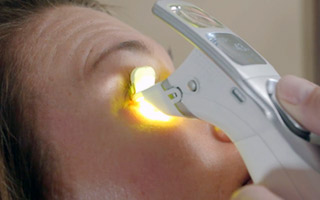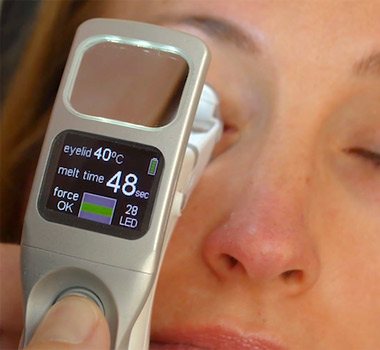 |
Meibomian Gland Dysfunction
iLux® treats MGD (Meibomian Gland Dysfunction) by the application of light-based heat and compression under direct visualization.
If you have MGD, (also commonly referred to as Dry
Eye) your symptoms may include irritated,
scratchy, dry, uncomfortable or red eyes, a burning sensation,
excessive tearing, blurred vision, or a feeling of something
foreign in your eyes. Excessive dry eyes may damage eye tissue,
scar your cornea (the front covering of your eyes) and impair
vision and make contact lens wear difficult. |
The iLux MGD treatment system:
We know how prevalent
MGD is among patients.
Now we can
treat you right in our office!
• Consists of the handheld iLux device and the sterile, single-patient-use disposable Smart Tip.
• Uses light energy to soften blockages of the meibomian gland orifices quickly and comfortably.
• Lets us manually adjust eyelid compression based on our clinical
judgment.
• Lets us view meibomian gland orifices, so we can tailor treatment to each patient's needs.
• Is great value for patients by bringing relief to more eyes.
The iLux® device allows us to view the eyelid margin through the magnifier, then warm the eyelid tissue within a therapeutic target range to melt the meibum blocking the orifices, and then apply compression to the eyelid to express the melted meibum through the orifices.
iLux can treat both upper and lower eyelids.
At all times, the amount of heat and pressure applied to your eyes is under our direct control
and we monitor the response of the eyelid margin and the comfort of the patient.
|
 |
| |
| The iLux® is packed with technology and features designed to make
your MGD treatment fast and effective. |
| |
|
What is MGD?
Many times in our lifetime, we will experience a "foreign body sensation" in our eye. That usually happens if the wind blows dust, an allergen or a foreign body into our eye or under an eyelid. This should not be dismissed as just an uncomfortable feeling. It needs to be remedied. It cannot be allowed to linger or fester
For many, the feeling of grittiness, dryness, burning or stinging or even excessive tearing cannot be relieved simply, or with over the counter methods. It may be the sign of a chronic condition
commonly referred to as dry eye syndrome. Yes, even tearing eyes are a sign of dry eye.
The tears your eyes produce are necessary for overall eye health and clear vision.
MGD means that your eyes do not produce enough tears or that you produce tears that do not have the proper chemical composition.
Also referred to as Dry Eye. MGD is more common as we age. It can also be caused by blinking or eyelid problems, medications like antihistamines, oral contraceptives and antidepressants, a dry climate, wind and dust, general health problems like arthritis or Sjogren's syndrome and chemical or thermal burns to your eyes.
| An estimated one-fifth of visits to eye care practitioners are related to ocular complaints secondary to dry eye, and as many as 25 percent of American adults may be affected by dry eye or have dry eye symptoms. These statistics indicate a significant need for access to professional care. |
|
Any condition that reduces the production, alters the composition, or impedes the distribution of the preocular tear film (POTF) may cause a noticeable irritation to the structures of the front surface of the eye and a degradation of vision. These conditions are often related to problems with the structure or function of the eyelids, cornea, or conjunctiva. Depending upon the severity of symptoms, individuals may be limited in their ability to see clearly and comfortably and may be at increased risk of developing secondary infection or chronic inflammation that may not respond to treatment.
The two most commonly encountered ocular surface disorders are tear film disorders and blepharitis. Additional sub-classifications include those dry-eye states associated with systemic connective tissue disorders, specifically Sjogren syndrome (SS). With regard to lipid deficient tear-film disorders, the involvement of meibomian gland dysfunction (MGD) has been proposed.
We perform specific tests to assist in differentiating the various forms of tear film abnormalities and identifying potential treatment strategies. Careful clinical observation, accurate diagnosis, and appropriate intervention can eliminate or minimize the deleterious effects of ocular surface disorders on the quality of life.
|